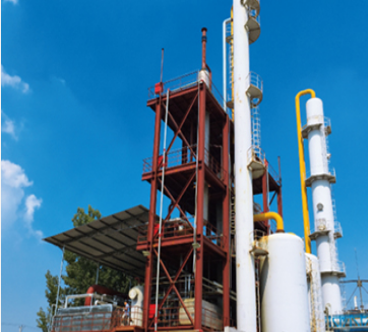沼氣的主要成分是CH4和CO2,將CO2從(cong) 混合氣中分離得到的高純度甲烷氣被稱為(wei) 生物天然氣。生物天然氣可以直接作為(wei) 石化天然氣的替代燃料,發展沼氣已成為(wei) 增加天然氣供應量的一個(ge) 重要方向。人類對天然氣需求量的增加推動了生物天然氣技術的發展。沼氣提純生物天然氣可高值化利用沼氣,有效減少沼氣工程因沼氣利用不充分而排空造成的溫室效應,具有環保和能源雙重效益。本文概述了沼氣提純技術及國內(nei) 外發展現狀,以期為(wei) 沼氣提純技術的發展提供參考。
The main components of biogas are CH4 and CO2. The high-purity methane gas obtained by separating CO2 from the mixture is called biological natural gas. Biogas can be directly used as an alternative fuel for Petrochemical Natural gas. The development of biogas has become an important direction to increase the supply of natural gas. The increase of human demand for natural gas has promoted the development of biological natural gas technology. Biogas purification of biogas can make high-value use of biogas, effectively reduce the greenhouse effect caused by insufficient utilization of biogas in biogas projects, and have the dual benefits of environmental protection and energy. This paper summarizes the biogas purification technology and its development status at home and abroad, in order to provide reference for the development of biogas purification technology.
1、沼氣特性
1. Biogas characteristics
沼氣是一種混合氣體(ti) ,其組成不僅(jin) 取決(jue) 於(yu) 發酵原料的種類及其相對含量,而且隨發酵條件及發酵階段的不同而變化。當沼氣厭氧反應器處於(yu) 正常穩定發酵階段時,沼氣的體(ti) 積組成大致為(wei) :甲烷(CH4)50%~75%,二氧化碳(CO2)25%~45%,水(H2O,20~40℃下)2%~7%,氮氣(N2)0~2%,少量的氧氣(O2),以及少於(yu) 1%的氫氣(H2)和硫化氫(H2S)。
Biogas is a kind of mixed gas. Its composition not only depends on the type and relative content of fermentation raw materials, but also changes with the different fermentation conditions and fermentation stages. When the biogas anaerobic reactor is in the normal stable fermentation stage, the volume composition of biogas is roughly: methane (CH4) 50% ~ 75%, carbon dioxide (CO2) 25% ~ 45%, water (H2O, 20 ~ 40 ℃) 2% ~ 7%, nitrogen (N2) 0 ~ 2%, a small amount of oxygen (O2), and less than 1% of hydrogen (H2) and hydrogen sulfide (H2S).
與(yu) 其它可燃氣體(ti) 相比,沼氣具有抗爆性良好和燃燒產(chan) 物清潔等特點。目前,沼氣主要應用在發電、供熱和炊事方麵,沼氣中的CO2降低了沼氣的能量密度和熱值,限製了沼氣的利用範圍,要去除沼氣中的CO2、H2S 和水蒸氣等將沼氣提純為(wei) 生物天然氣(BNG)。生物天然氣可壓縮用於(yu) 車用燃料(CNG)、熱電聯產(chan) (CHP)、並入天然氣管網、燃料電池以及化工原料等領域。汽車使用生物天然氣不僅(jin) 可以降低尾氣排放造成的空氣汙染,而且溫室氣體(ti) 的淨排放量減少75%~200%,生物天然氣可混入現有的天然氣管網,降低對石化能源的依賴。
Compared with other combustible gases, biogas has good explosion resistance and clean combustion products. At present, biogas is mainly used in power generation, heat supply and cooking. The CO2 in biogas reduces the energy density and calorific value of biogas and limits the scope of biogas utilization. It is necessary to remove CO2, H2S and water vapor in biogas and purify biogas into biological natural gas (bng). Bio natural gas can be compressed for vehicle fuel (CNG), cogeneration (CHP), integration into natural gas pipeline network, fuel cell, chemical raw materials and other fields. The use of biogas in automobiless can not only reduce the air pollution caused by exhaust emissions, but also reduce the net emission of greenhouse gases by 75% ~ 200%. Biogas can be mixed into the existing natural gas pipeline network, reducing the dependence on petrochemical energy.
2、沼氣提純技術
2. Biogas purification technology
目前填埋氣提純工藝有變壓吸附法(PSA)、水洗法、化學吸收法、膜分離法、選擇分離法等,在目前世界範圍內(nei) 工藝較為(wei) 成熟、應用相對較多的方法是變壓吸附法(PSA)、化學吸收法(胺法淨化)、膜分離法。
At present, landfill gas purification processes include pressure swing adsorption (PSA), water washing, chemical absorption, membrane separation, selective separation, etc. at present, the more mature and widely used methods in the world are pressure swing adsorption (PSA), chemical absorption (amine purification) and membrane separation.

2.1變壓吸附法(PSA)
2.1 pressure swing adsorption (PSA)
變壓吸附法(PSA)是在加壓條件下,利用沼氣中的CH4、CO2以及N2在吸附劑表麵被吸附的能力不同而實現分離氣體(ti) 成分的一種方法。組分的吸附量受壓力及溫度的影響,壓力升高時吸附量增加,壓力降低時吸附量減少;當溫度升高時吸附量減小,溫度降低時吸附量增加。變壓吸附對氣體(ti) 來源的要求非常嚴(yan) 格,H2S的存在會(hui) 導致吸附劑永久性中毒,並且變壓吸附要求氣體(ti) 幹燥,所以變壓吸附前要先脫除H2S和H2。
Pressure swing adsorption (PSA) is a method to separate gas components under pressurized conditions by using the different adsorption capacities of CH4, CO2 and N2 in biogas on the adsorbent surface. The adsorption capacity of components is affected by pressure and temperature. When the pressure increases, the adsorption capacity increases, and when the pressure decreases, the adsorption capacity decreases; When the temperature increases, the adsorption capacity decreases, and when the temperature decreases, the adsorption capacity increases. PSA has very strict requirements on gas source. The presence of H2S will cause permanent poisoning of adsorbent, and PSA requires gas drying. Therefore, H2S and H2 should be removed before PSA.
吸附材料在該技術中起到關(guan) 鍵的作用,一般采用不同類型的活性炭、沸石、矽膠、氧化鋁和分子篩作為(wei) 吸附材料。不同的吸附材料對沼氣的純化效果各不相同。目前,以活性炭和分子篩為(wei) 主的碳基吸附劑,在研究沼氣提純方麵經常被使用。近年來出現的一些新型吸附材料,如有序介孔材料、胺修飾吸附劑和金屬框架物(MOFs)對CO2具有很高吸附選擇性,應用前景廣闊,而且MOFs被認為(wei) 是在CO2分離方麵具潛力。
Adsorption materials play a key role in this technology. Generally, different types of activated carbon, zeolite, silica gel, alumina and molecular sieve are used as adsorption materials. Different adsorption materials have different purification effects on biogas. At present, carbon based adsorbents based on activated carbon and molecular sieve are often used in the study of biogas purification. In recent years, some new adsorption materials, such as ordered mesoporous materials, amine modified adsorbents and metal frameworks (MOFs), have high adsorption selectivity for CO2 and broad application prospects. Moreover, MOFs are considered to have the most potential in CO2 separation.
 首頁- betway体育入口 > 公司新聞
首頁- betway体育入口 > 公司新聞
 2022-06-11
2022-06-11
